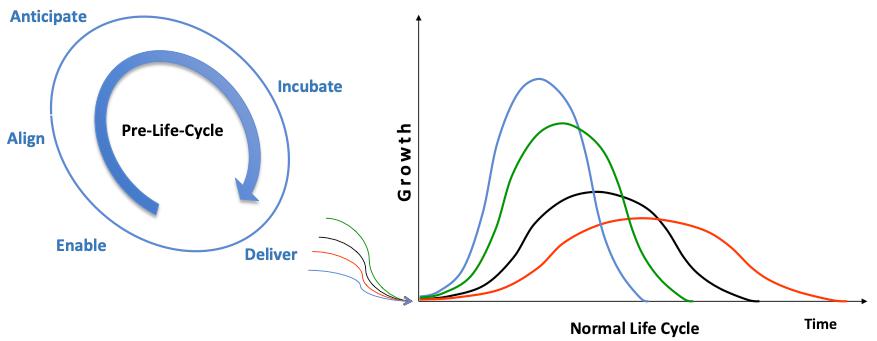
03 May Why many change efforts fail. Maybe it has to do with how we lead change…
In my previous blogs I have written about the extreme pace of change we experience as leaders and organisations. We are indeed on the cusp of an Extreme Future—a future that accelerates on a rising super S-curve in a VUCA world. For the Age of Change we need a new kind of Change Leadership— leadership that recognises and leads change as a continuously dynamic ecosystem.
Globally and for decades we have been experiencing what I would call the Change Deficit. The success record of organisations for change initiatives over many decades has been very disappointing to say the least. Many change initiatives do not deliver their intended outcomes or achieve their goals. Failed and partially successful change initiatives cost huge amounts in resources—time, money, human energy and many other lost opportunities. There is a longstanding popular statistic that claims the failure rate for change initiatives is as high as 70% for all initiatives. This ostensible cliché turns out to be fact and not fiction—thus there is indeed something I would call a Change Deficit!
Despite vast resource expenditures on change efforts, organisations don’t achieve what they intended. Instead, often what they do get from failed or challenged change attempts are an incredible loss of trust in leadership, fatigued and disengaged employees, disgruntled customers and poor performance results. On top of this disappointment, to add insult to injury, leaders are blaming their change consultants and project managers for their wrong advice to lead such initiatives, while the consultants blame the leaders for not being fit for the task to lead or champion the change efforts. This well-known blame game will not solve the challenges of the Change Deficit in the Age of Change. The truth is that both leaders and their advisors are singing from the same hymnbook—both parties are leading change with the same outdated models and frameworks. This Change Deficit is accentuated by an ongoing debate about the real success rate of change initiatives. The debate has been narrated in numerous reports and media. For example, Huges1 published a study that disputes the validity of the longstanding failure rate of 70% for change initiatives. He questions the supporting evidence for such a very specific and alarming statistic.
Notwithstanding Hughes1 difference of opinion, there are numerous studies that corroborate the statistics of the Change Deficit. For example, in a study by IBM2, named ‘Making Change Work’, they have found that:
- 41% of change projects were considered successful in meeting project objectives within planned time, budget and quality constraints.
- 44% of change projects missed at least one time, budget or quality goal.
- 15% of change projects either missed all goals or were stopped by management.
Another service called Calleam.com3 keeps an up-to-date database on major failed change programs and other types of projects worldwide. Standish4 compiles what they call their annual CHAOS report on the success rates of management information system change projects. For example, in 2016 they reported that between 2011 and 2015, on average only 29% of projects are deemed successful. The remaining 71% were either failed or ‘challenged’ projects. Wrike’s5 collection of project management statistics for 2015 states that only 64% of projects they studied met their goals. IPA (Independent Project Analysis Institute) 6 evaluates between 700 and 800 large capital projects every year. They have found that 65% of those projects failed to meet their business objectives.
What we have concluded from the debate on the success of change initiatives and the disappointing success statistics, is that it does not matter the kind of industry, nor the type of project—whether it is called a ‘change initiative’, a capital project, a new technology application, or some other initiative, the success statistics are similar. Perhaps, the norm of a 70% failure rate for change initiatives might be slightly overstated—the actual failure rate may differ depending on different viewpoints. Nevertheless, even if the failure rate is as ‘low’ as for example 30%, which it clearly isn’t, such a ‘low’ failure rate is still too high to accept as a satisfactory performance outcome for change initiatives. In the Age of Change, where the pace of change is increasing exponentially on a rising super S-curve, it is vital that we lead change initiatives at a much higher success rate. As leaders, we must turn the Change Deficit around. We are in desperate need of new leadership frameworks and change oriented behaviours that will guide us to significantly reduce this Deficit.
IncludeChange emphasise the fact that change lives through two life cycles. The first life cycle is a novel concept we call the ‘Pre-Life-Cycle’ and the second is the normal life cycle.

The PreLifeCycle is a function of the change ecosystem. The PreLifeCycle stems from a natural characteristic of the broader concept of change itself. However its existence has been ‘unnoticed’, and therefore entirely underutilised or even ignored. IncludeChange has designed a novel leadership framework that is based on the PreLifeCycle to lead change more successfully.
The PreLifeCycle of many ordinary things is clearly visible in everyday life. Metaphorically for example, consider the many actions and processes that must happen before new seedlings jut their first sprigs above ground, or before human or animal babies are born. The entire eco-system has to be in alignment in order to produce viable new live. The same principles that apply in nature, also apply to an ecosystem that produces viable change initiatives.
In the Age of Change we have to understand the Pre-Life-Cycle and use it to our mutual advantage. We believe that leaders, who lead change with the principles of the Pre-Life-Cycle would be significantly more successful to prepare for, identify and implement successful change initiatives and would encounter considerably less resistance. The organisations they lead will be continually pre-prepared and fit for any change—positive or negative.
The change ecosystem drives the PreLifeCycle. It is the birthplace of all change ideas and initiatives—viable and non-viable. The process of the PreLifeCycle must occur before initiatives are launched or announced to be implemented, to have a chance of being ‘born’ successfully. When we don’t lead change through the PreLifeCycle in an aligned ecosystem, the normal result is failed or sub-optimal change initiatives.
The PreLifeCycle has five stages namely, Enable, Align, Anticipate, Incubate and Deliver. In the change ecosystem these stages happen concurrently and continually, and we have to prepare our organisations to lead change in that way.
During the Enable stage, we lead the organisation to apply a variety of different mindsets and thinking models. That allows your organisation to pluck a rich harvest of potentially viable change initiatives. Leading a change enabling environment and culture makes your organisation not only ready for specific initiatives, but also fit for continual change. Inclusion of your organisation’s people and stakeholders in the process is vital. In the Align stage your organisation’s capacities, capabilities, resources, and accountabilities are aligned to enable change initiatives—seen and unforeseen. Your entity becomes agile and resilient to lead change pro-actively. In the Anticipate stage, the your focus turns to the change forces that may cause opportunities and challenges ahead of the curve. In this stage we deal with lots and many kinds of inputs, data, information and knowledge, and through a rigorous filtering and synthesis process we extract a viable number of potential change initiatives. Next, in the Incubation stage, we create the necessary conditions to develop, test, experiment or pilot a selection of initiatives that has the potential to sustain successful normal life-cycles—that is the second cycle. In the final Deliver Stage, we take selected change initiatives, and through change management processes, integrate them into your organisation. Once integration is complete, the new initiative is ‘born’ and ready to start its normal life cycle—its second cycle.
The second cycle of your change initiative is the familiar or normal life cycle that starts the moment a change initiative is delivered to go-ahead. The second cycle is a function of the individual initiative. From the go-ahead, a change initiative will live through its normal life stages namely, birth or inception, growth, maturity, plateau, decline, and eventually demise. The normal life cycle shows and determines the viability and longevity of a specific change initiative. The ultimate success of the second life cycle of our change initiatives is determined by how well we have led change in the PreLifeCycle.
A key leadership task is to pro-actively lead the change ecosystem with the principles of the PreLifeCycle so that your organisation can become change-fit for any change initiatives—seen and unforeseen, and to select only those specific initiatives that would be viable and successful. It is important to note that leading the process of the PreLifeCycle never stops—it is a continual activity in any organisation that wants to become fit for the Age of Change. The process is the crucible and birthplace of new individual change initiatives. Whenever it produces viable initiatives, they are implemented through normal change management processes. Change initiatives that are thus created stand a much better change of being successful.
In a previous blog, I explained the difference between modern Change management and Change leadership in the Age of Change. Change initiatives can go wrong in many ways, as I have explained above. The change management industry lists hundreds of mistakes and potential solutions we should follow to improve the implementation of change initiatives. All that advice and insight is good and it must continue. However, the focus of that work is entirely directed on the second normal life cycle of specific change initiatives. We believe change leadership, as opposed to change management, is about turning leaders’ focus to the PreLifeCycle, to when and where viable change initiatives originate from a well-managed change ecosystem. IncludeChange sees this new mindset as the new way to lead in the Age of Change. We believe that when leaders and organisations focus their attention on the PreLifeCycle, more viable change initiatives will be identified and selected. Secondly, initiatives that are led in this way will have less implementation problems to deal with.
IncludeChange developed a novel and integrated leadership framework that will help you to lead in the Age of Change. The leadership framework comprises of the five stages of the PreLifeCycle of change. The IncludeChange leadership framework also provides comprehensive leadership methodologies and detail actions to lead trusting relationships in inclusive ways and shows you how to lead and govern your organisation to execute its mutual purpose at extraordinary heights of performance.
1. Hughes, M. 2011, ‘Do 70 percent of all organisational change initiatives really fail?’, Journal of Change management, vol. 11, no. 4, pp. 451-464.
2. Making Change Work, 2013, Report by IBM.
3. Calleam: http://calleam.com/WTPF/
4. Standish report: https://www.standishgroup.com/outline
5. Wrike: https://www.wrike.com/blog/complete-collection-project-management-statistics-2015/#failure
6. Merrow, E.D. 2011, Industrial Megaprojects, Concepts, Strategies and Practices for Success, Wiley, New Jersey.




No Comments